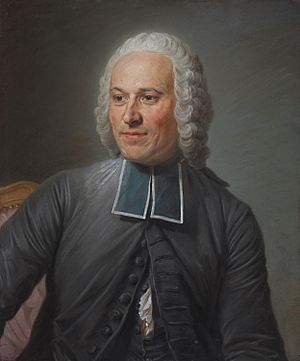Jean-Antoine Nollet facts for kids
Quick facts for kids
Jean-Antoine Nollet
|
|
|---|---|

Portrait by Quentin de La Tour, c. 1753
|
|
| Born | 19 November 1700 Pimprez, Kingdom of France
|
| Died | 25 April 1770 (aged 69) |
| Known for | Discovery of osmosis |
Jean-Antoine Nollet (French: [ʒɑ̃ ɑ̃twan nole]; 19 November 1700 – 25 April 1770) was a French scientist and a churchman. He is famous for his amazing experiments with electricity and for discovering osmosis. Because he was a deacon in the Catholic Church, people often called him Abbé Nollet.
Contents
A Life of Discovery
Nollet started studying in 1715. He earned a master's degree in Paris in 1724. In 1728, he became a deacon in the Catholic Church. Even though he didn't continue his church career, he used the title of Abbé his whole life.
Nollet was very interested in the new science of electricity. In 1728, he joined a group called the Société des Arts. This group helped scientists use natural philosophy in practical ways.
Working with Other Scientists
Being part of this group helped Nollet meet important scientists. He likely worked with Du Fay and Réaumur. These were leading members of the Royal Academy of Sciences.
From about 1731 to 1735, Nollet helped them with many experiments. These included studies on insects, frogs, temperature, air, light, magnets, and electricity. He worked closely with Du Fay on electrical experiments. In 1734, he traveled with Du Fay to meet physicists in England. He also visited the Netherlands in 1736.
Becoming a Recognized Expert
Nollet became a member of the Royal Society of London in 1734. He is thought to have named the Leyden jar. This was a new device used to store electricity. To pay for his own tools, Nollet started building and selling copies of scientific instruments in 1735.
By 1743, the Royal Academy of Sciences saw Nollet as the main expert on electricity. In 1753, he became the first professor of experimental physics in France. This was at the collège de Navarre at the University of Paris. In 1762, he became the director of the Royal Academy of Sciences.
Nollet gave lectures to make physics popular. He used many instruments in his talks. His lecture notes were published as Leçons de physique expérimentale and L’Art des expériences. These books inspired many self-taught scientists for a long time.
Amazing Experiments
Nollet performed many exciting experiments with static electricity.
The Electric Boy
One famous experiment was called "The Electric Boy." A young man would hang from the ceiling using silk ropes. These ropes stopped electricity from escaping. Nollet would then electrify the boy. This made the boy's body collect an electric charge. Objects would stick to him. If another person came close, sparks could fly between them!
The Monk Chain
In 1746, Nollet gathered about 200 monks. They stood in a large circle, about a mile (1.6 km) around. They held iron wires connecting them all. Nollet then sent electricity from a battery of Leyden jars through the human chain. He saw that every monk reacted to the electric shock at almost the same time. This showed that electricity travels very, very fast.
Discovering Osmosis
In 1748, Nollet discovered osmosis. This is a natural process that happens in living things. He covered the opening of a flask of alcohol with a pig bladder. Then, he put the flask into water. After a few hours, the pig bladder swelled up. When he poked it, the liquid inside shot out more than a foot high! This showed how liquids can move through certain membranes.
Other Inventions
In the same year, he also invented an electroscope. This device helps detect if an object has an electric charge. In 1750, Nollet was the first to describe electrostatic spraying. He noticed that water flowing from a container would turn into a fine mist if the container was electrified and near the ground.
His Writings
Nollet wrote several important books and papers about his experiments and discoveries.
- 1743-1764: Leçons de physique expérimentale (6 volumes). These books collected his popular lectures.
- 1770: L'Art des expériences. This book also shared his experimental methods.
See also
 In Spanish: Jean-Antoine Nollet para niños
In Spanish: Jean-Antoine Nollet para niños
- List of Roman Catholic scientist-clerics
Images for kids




